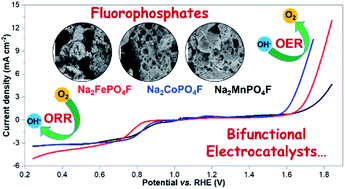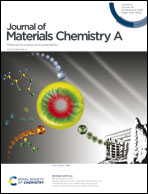Metal fluorophosphate polyanionic insertion hosts as efficient bifunctional electrocatalysts for oxygen evolution and reduction reactions†
Abstract
Metal–air batteries with high energy density have emerged as key players in the energy storage sector. They operate on two underlying processes, namely, the oxygen reduction reaction (ORR) and the oxygen evolution reaction (OER). It provides the impetus to design efficient, earth-abundant and economic bifunctional electrocatalysts vis-à-vis precious metal-based catalysts. In this perspective, a few polyanionic battery insertion materials have been reported as potential electrocatalysts. In the current work, metal fluorophosphate (Na2MPO4F, M = Fe/Co/Mn) family of sodium insertion materials have been shown as a new class of bifunctional electrocatalysts with robust structural stability. In particular, Na2CoPO4F was found to exhibit superior catalytic performance with an onset potential of 0.903 V (vs. RHE) for the ORR and an overpotential of 380 mV (vs. RHE) for the OER. The underlying mechanism and kinetics were explored using ab initio computational studies. Overall, polyanionic transition metal fluorophosphates were explored for the first time as bifunctional electrocatalysts capable of working as potential cathode materials in hybrid metal–air batteries.



 Please wait while we load your content...
Please wait while we load your content...